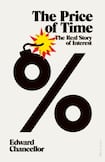
A mania for building railways gripped Britain midway through the 19th century: 1,200 rail building projects were promoted in 1845, at a cost greater than the entire income of the country.
At the end of the last century, the real estate value of the Imperial Palace in Tokyo was estimated to exceed the value of all property in California.
In 2017, a cryptocurrency called the Useless Ethereum Token experienced a fivefold increase in value. This same currency had a logo showing the middle finger and a website that warned investors “Don’t Buy These Tokens.”
The thread that joins these stories together is the value placed on wealth and capital by the level of interest rates. This relationship is considered by Edward Chancellor in The Price of Time.
The Wardrobe Department by Elaine Garvey: Evocation of youthful self-discovery is well wrought and truthful
What time is kick-off and what TV channel is Wales v Ireland on? All you need to know about the Six Nations clash
The Movie Quiz: How many actors have received Oscar nominations for Star Wars films?
What next for James Bond under Amazon? Marvel-style TV spinoffs on Prime or Miss Moneypenny specials?
The book opens with a striking graph displaying the key theme of this work. It displays the trend in interest rates over five millennia. It shows a clear direction of rates staying low, with only a few periods of increases.
When interest rates are very low, the return on savings declines and the cost of borrowing is cheaper. This encourages spending now. If interest rates increase, saving becomes more attractive and borrowing to fund spending becomes more expensive.
This is elegantly summarised: “By acts of borrowing and lending, and saving and investing, we shift expenditures across time. Interest is the toll levied on borrowers for bringing forward consumption and the fee paid to savers for moving consumption into the future. The level of interest regulates the traffic on the bridge and its general direction.”
The author argues that this bridge is broken, that interest rates have stayed too low for too long and are the cause of massive financial stability risks and increasing inequality.
This case is made by a detailed study of the history of interest and an examination of the consequences of low rates.
Lively and lucid
The history sections of this book are enhanced by a lively and lucid writing style. The recording of borrowing and lending dates to the ancient Mesopotamians. A loan document dated from the 24th century BC shows debts of 720 litres of barley with an estimated interest rate of 33 per cent.
The lending of money, at interest rates that were perceived to be excessive, attracted fierce criticism across centuries. St Ambrose compared this to a sea storm that brings universal shipwreck.
The commercial opportunities created by low rates also abound in this history. The exploits of John Law, the son of a Scottish goldsmith who was appointed finance minister of France in 1720, is a leading example of how this can turn into excess and, finally, ruin.
Law took over a company that possessed a monopoly on trading rights across huge parts of the United States. Those lucky enough to own shares in the Mississippi Company became extravagantly wealthy.
In 1719 an edict had to be issued forbidding servants from wearing velvet sleeves or silk shirts. Law’s personal carriage was stoned when the speculative bubble inevitably collapsed.
The Price of Time offers multiple examples of financial excess and collapse. The author strongly contends that low interest rates are a leading cause of recessions, and even depressions.
As interest rates stay low, and are expected to stay low, it becomes too difficult to value future income. Capital is not properly allocated and incentives encourage speculation and investment into other assets that surge in value. The cycle is always the same: “Easy money fostered credit growth, and credit growth fostered speculative excesses.”
This slows down, according to this argument, the bankruptcy and insolvency cycle within economies, encourages financial engineering that enriches a small few and also undermines the viability of saving for the future.
Economic costs
The merits of these arguments seriously weaken as they are repeatedly overstated.
My life as a politician is indelibly marked by the aftermath of the global financial crisis. At no point during those difficult years was economic growth adequately robust and inflation sufficiently high to allow the step change in interest rates that this book advocates.
A regime change in interest rates might have dampened financial speculation but this would have come with huge economic costs.
A contender for the leadership of the Conservative Party recently argued that there are no solutions, only trade-offs. I disagree: to suggest there are no solutions verges on nihilism. But trade-offs are the very essence of economic policy decisions.
This is not sufficiently considered in The Price of Time. This turns a hefty and learned volume into too much of a polemic. That said, it is worth reading. Our economies are experiencing a regime change in interest rates. This book has verve and will help any reader understand why this change is coming, even if such understanding might not lessen the costs.
Paschal Donohoe is the Minister for Finance and president of the Eurogroup.















